How Trump’s 50% Copper Tariff Will Affect The US And The World
US President Trump on July 9th announced a 50% tariff on copper imports into the US, ostensibly to boost US copper production and make the country self-sufficient in a metal that has become critical to the future economy.
But the US mines and refines very little copper; it imports a million tonnes a year mostly from Canada and Chile and only exports 250-300,000 tonnes, out of global mine production in 2024 of 23Mt.
A 50% tax on imports will do nothing to change these facts and its effects will be extremely damaging to end users and their customers, who ultimately will pay the tariff through higher prices.
Here we take a deep dive into the tariff’s effects inside the US.
Arbitrage opportunity
Copper lit up the chart following Trump’s glib announcement Tuesday that imports of copper to the United States would be tariffed at 50% — the same as imports of steel and aluminum. A 200% tariff on pharmaceutical imports was also proposed.
The base metal climbed as much as 17% in New York on Tuesday, a record one-day spike to an all-time high, according to Bloomberg. As of this writing, Thursday, it was trading at $5.58 a pound.
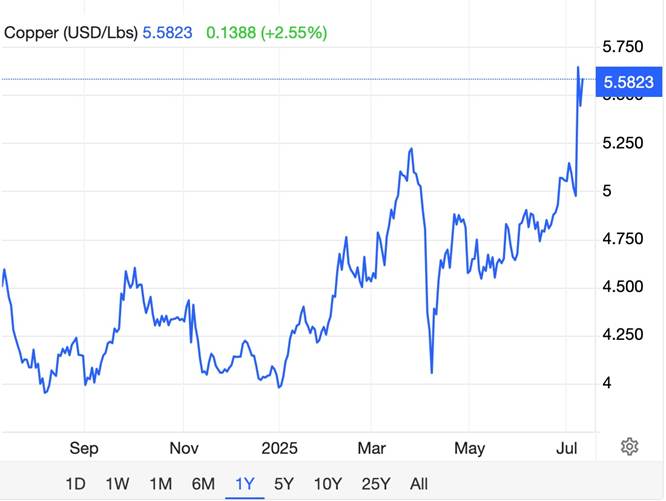
Source: Trading Economics
The announcement on the copper tariff was light on details other than it appears to be a desire by the Trump administration to revive the US copper industry and to ensure security of supply for what is increasingly becoming a critical material for civilian and military purposes. It would take effect on Aug. 1.
In fact, copper traders and buyers have been bracing for what they thought would be a 25% tariff on copper since February, when Trump announced a probe into potential tariffs on copper products.
Trump’s February executive order said that the US “has ample copper reserves, yet our smelting and refining capacity lags significantly behind global competitors.” The country only has two operating smelters, while China has around 200.
US government officials have argued dumping and overcapacity in the global market have weighed on domestic production, leaving America reliant on foreign sources of copper for vital industries such as weapons manufacturing. (Bloomberg)
The prospect of a tariff swiftly resulted in large amounts of copper being shipped to the United States before the duty takes effect. Copper stocks at the Comex reached multi-year highs in late March, while those elsewhere tightened. About 500,000 tonnes went to the US at that time, compared to normal monthly volumes of around 70,000t.
This also created an arbitrage opportunity for copper traders.
Comex copper prices have risen higher than those on the London Metal Exchange — the international benchmark. Following Trump’s comments, Comex contracts reached an unprecedented 25% premium over LME prices, as spot contracts on the LME tumbled below futures.
Bloomberg reported much of the refined metal being sent to the US is coming from copper mines in Peru and Chile, two of the top five copper-producing countries worldwide. Chilean state-run Codelco’s first-quarter shipments to the US were 50% higher than the same period last year. The metal is also being rerouted from buyers in China, which is the world’s largest processor and consumer of copper.
However, once the tariff kicks in, the steady stream of copper heading to the US will slow, and the gap between Comex and LME prices is likely to narrow.
Some analysts worry prices outside the US could be dragged lower as countries like Chile, Peru and Canada shift supplies elsewhere in response to the tariffs.
Price forecast
Which leads to the question: Is the current copper rally sustainable?
“The US does not have nearly enough mine/smelter/refinery capacity to be self-sufficient in copper,” Jefferies LLC analysts including Christopher LaFemina wrote in a note. “As a result, import tariffs are likely to lead to continued significant price premiums in the US relative to other regions.” (Bloomberg)
One expert says that strong global demand for copper combined with tight supply has raised copper to record heights this year, and prices, especially in the US, will continue to rise due to the impending tariff.
“Copper has been seeing a huge tailwind this year,” Ken Hoffman, commodity strategist at Red Cloud Securities, told BNN Bloomberg in an interview.
“You have every military in the world trying to increase budgets, there’s lots of copper in military hardware. Put on top of that the electrification of everything, there’s huge copper needs there… and you’ve just added gas to the fire saying we’re going to put these silly tariffs on copper.”
Hoffman said U.S. companies will be left paying more for copper if new tariffs are placed on the metal, and the increased cost is exacerbated by a declining U.S. dollar.
“If I’m an automaker in the U.S. and I need copper tubing or if I’m a utility in the U.S. putting up copper wire, I’m definitely going to be paying those U.S. prices. And so, those surcharges will be put on to the U.S. market, the rest of the world will not pay that,” he said.
“In addition to that, you have the U.S. dollar, which is down about 15 per cent this year… so all metals which are priced in U.S. dollars are seeing this huge boost by dollar destruction.”
Money Metals’ contributor Jesse Colombo says Copper’s 13% surge [Tuesday] propelled it decisively above a critical resistance zone that has capped gains for several years, likely marking the start of a new bull market.
As the chart below shows, that resistance zone is $5.00 to $5.20.
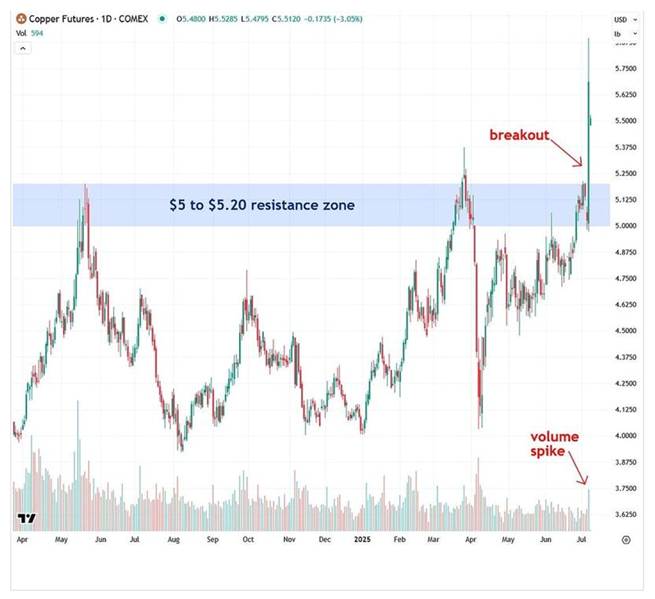
Source: Money Metals
Zooming out, Colombo believes that a copper bull market was taking shape well before Trump’s copper tariff announcement. The chart below shows copper forming an ascending triangle pattern over the past four years, a classic bullish formation.
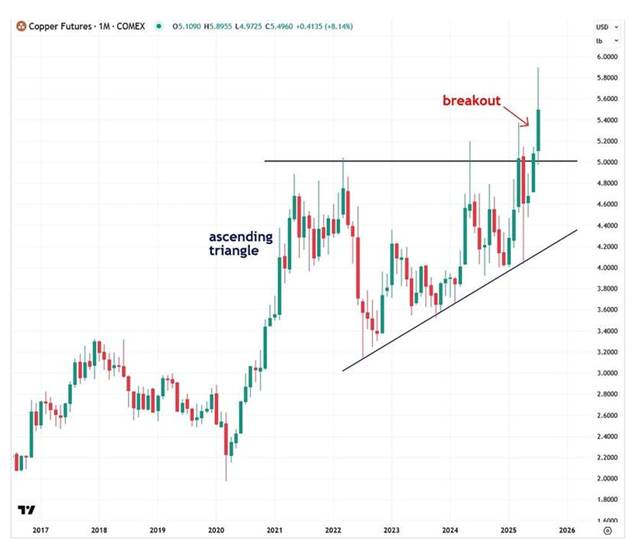
Source: Money Metals
Now that this breakout has occurred, I believe it is likely to match the strength and momentum of the powerful 2020 rally. Applying the measured move principle from technical analysis, this breakout projects an advance of $3 per pound — which would take copper to around $8, representing an impressive gain of 60% from the $5 breakout point.
Colombo says he also sees a similar ascending triangle forming copper mining stocks as highlighted in the Global X Copper Miners ETF (COPX).
“I believe that a breakout in COPX is likely to signal a powerful upcoming bull run in copper mining stocks,” Colombo states, adding that miners with greater exposure to US copper production are likely to outperform those focused on non-US mines. The COPX is charted below.
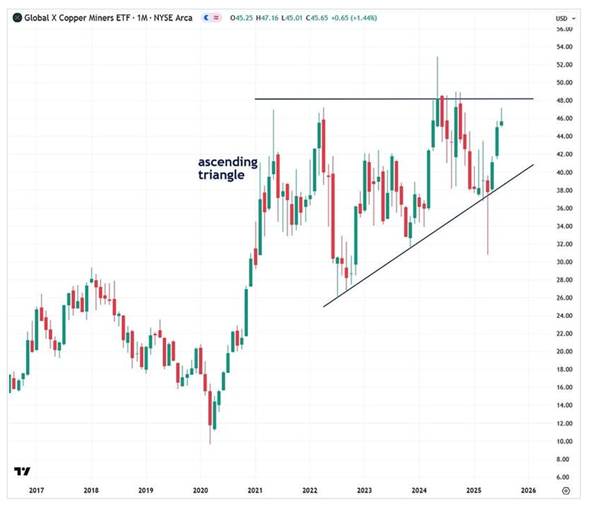
Source: Money Metals
“We are seeing a shortage in supply, and growing demand particularly with the data centres, the movement to cleaner energy, and just generally as the emerging markets start investing in industrialization, which is a big consumer of copper.
So, everyone is in agreement that the copper demand is outgrowing the supply side.” Barrick Mining Corp CEO Mark Bristow
Where does the US get its copper from?
The United States is to a large degree import-dependent on copper. According to the USGS, in 2024 the US imported 810,000 tonnes of refined copper and virtually zero ores and concentrates. The latter is explained by the fact that the country only has two smelters.
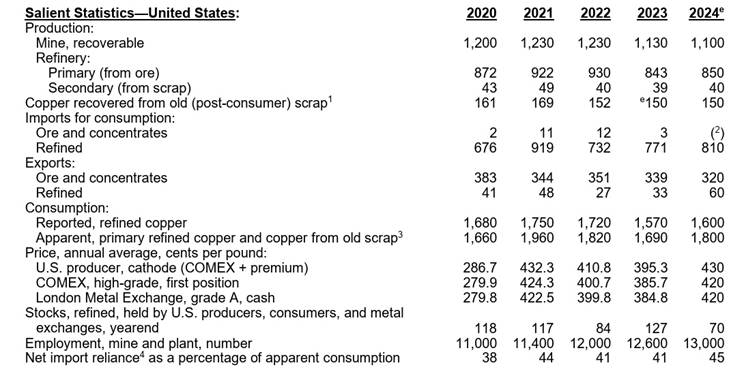
Source: USGS
It exported 320,000 tonnes of ore and concentrates and 60,000 tonnes of refined copper.
The United States produces domestically just over half the refined copper it consumes each year. The rest, almost a million tonnes, is imported. (Reuters)
More than two-thirds of US domestic refined copper is mined in Arizona, including from Freeport-McMoRan’s five mines: Morenci, Bagdad, Safford, Sierrita and Miami.
90% of the roughly 1 million tonnes of refined copper imports last year originated in the Americas, namely Canada, Chile and Peru.
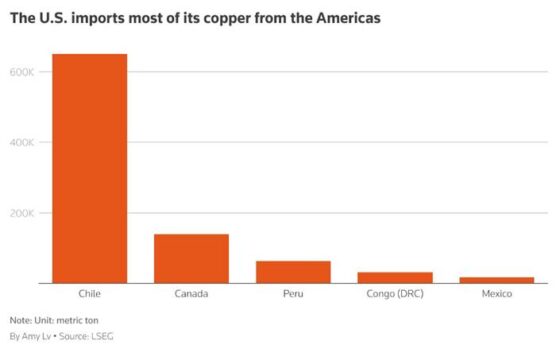
Remember, we are talking about refined copper, not raw copper, like concentrate and cathodes.
The two charts below show that, while China dominates copper refining, most of the ore that feeds its smelters is mined elsewhere, especially Latin America. According to the USGS, Chile and Peru together mined roughly a third of global copper last year.
Reuters notes that China has made inroads into the Democratic Republic of Congo, which is now the world’s second largest copper producer after overtaking Peru. For example, the Kamoa-Kakula copper mine in the DRC is a joint venture between Ivanhoe Mines and China’s Zijin Mining. 100% of initial production will be split between two Chinese companies, one of which owns 39.6% of the JV project.
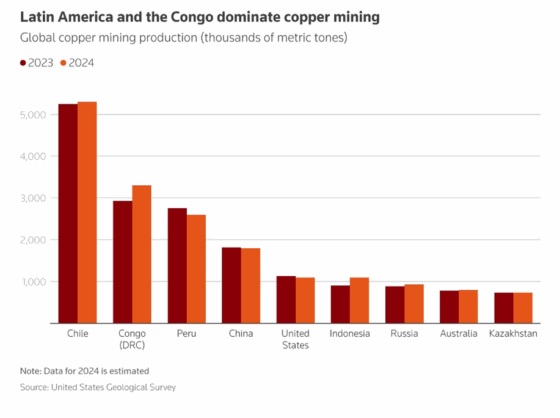

Effects on Canada
Canada’s Trade Minister Melanie Jolie said Canada would fight back against Trump’s 50% copper tariff.
According to Natural Resources Canada, via CTV News, the US was the country’s largest copper importer in 2023, accounting for 52% of the total export value, followed by China and Japan.
However, the Globe and Mail quoted BMO economist Robert Kavcic saying the impact will be lighter than the same percentage tariffs on steel and aluminum.
“Total Canadian exports of copper to the U.S. ran at $5.7 billion in the twelve months through May, or roughly 0.2% of GDP. That adds onto $34 billion of steel and aluminum exports, for a combined 1.3% of GDP. Regionally, Quebec remains in the crosshairs, accounting for most of Canada’s U.S. copper shipments.”
He added BC is also a major copper producer but most of its exports go to Asia.
Can the US mine its way out?
Can the US mine its way out of its copper import dependence? According to experts, it’s unlikely, at least in the short term.
“The longer-term aim of the Trump administration may be for the US to be fully self-sufficient in copper, but mines take too long to develop for this to be achieved in less than a 10-year time horizon,” Jefferies analysts wrote in the Bloomberg piece. “The US will still rely on foreign mines to meet demand for the foreseeable future.”
Indeed, building a copper mine in the US, from discovery to production, can take upwards of 20 years, with many hurdles to overcome including community and indigenous buy-in, environmental issues and permitting.
Breaking that down, at least two major copper mining projects are on hold due to permitting issues — Resolution in Arizona owned by BHP and Rio Tinto, and Antofagasta’s Twin Metals project in Minnesota.
Other projects are in the pipeline, but they will take time. The closest is Taseko Mines’ Florence, which expects to produce cathodes by year-end. Hudbay’s Copper Road is going into the feasibility stage, Arizona Sonoran’s Cactus Road has a PEA, and Ivanhoe Electric’s Santa Cruz has only just published a prefeasibility study.
As these mine developers wait, and 50% tariffs take effect, end users that buy this expensive copper will either have their margins squeezed or will pass the tariff onto their customers. There is no doubt that this and other tariffs are inflationary.
Impacts on end users
Soon after the tariff announcement, Bloomberg published a story that said Trump’s plans to charge copper importers hefty duties has already caused a spike in costs for US factories.
The article says such factories rely on overseas supplies for nearly half of the copper they buy.
Some are even calling out the tariffs as a direct contradiction to Trump’s promise to reshore US manufacturing and challenge China.
“Any restrictions on US imports of copper cathode would merely redirect copper supply to China,” top US copper importer Southwire Company LLC wrote to the US Commerce Department in April.
“At the same time, US copper producers would face significant shortages of supply, particularly in the short- and medium-term, as US copper production cannot increase fast enough to fill the supply gap.”
As for how the tariff could affect specific industries, CBS News quotes Ryan Young, a senior economist at the Competitive Enterprise Institute, a nonpartisan think tank, saying that copper tariffs could make maintaining the nation’s electric grid more expensive. The biggest users of copper will be most exposed to the tariff, which includes a vast array of industries — everything from construction to semiconductors, electric vehicles and solar panels.
Daan de Jonge from Benchmark Mineral Intelligence said that “a 50% price hike will have inevitable ripple effects on the cost of new infrastructure, the cost of housing, the cost of fridges, cars, air conditioning.”
Building construction accounts for the largest share of US copper consumption at 45% of the total, followed by electrical at around 22%.
Mish Talk says the number of jobs potentially created by new copper mines will be dwarfed by the users of copper, who will pay a hefty premium for it. The price of copper is likely to remain higher in the US, as less copper is imported because of the tariff, while demand continues to grow due to its myriad uses. The country simply can’t, with two smelters, refine enough copper to make up for the million tonnes it imports. And it can’t, with the snap of a finger, put new mines into production. This takes years, if not decades.
The role of scrap
A shorter-term solution would be for the US to boost production from copper scrap, which has historically been shipped to processors overseas, particularly in China, states the above-cited Bloomberg article.
Those flows ground to a halt as the spike in Comex prices made US scrap more expensive, but for now the country lacks the smelting capacity to fully work through the backlog of scrap that’s been piling up.
Major players in the US copper industry have called on President Trump to restrict exports of ore and scrap instead of imposing tariffs on imports. They’ve also warned that putting tariffs solely on refined copper could lead to a flood of imports of value-added copper products that aren’t subject to the levies.
A complementary article in Fortune notes Trump’s copper tariff is ushering in “the Golden Age of scrap metal”, with the surge in Comex copper prices invariably feeding into scrap.
“That might now turn out to be a lifeline, even if temporary, while policymakers await the broader impact from tariffs.”
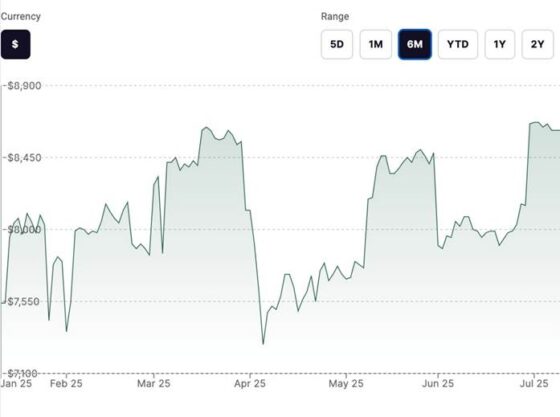
US copper scrap price. Source: Metaloop
Demand surge
Global copper consumption has increased steadily in recent years and currently sits at around 26 million tonnes. 2023’s 26.5 million tonnes broke a record going back to 2010, according to Statista. From 2010 to 2023, refined copper usage increased by 7 million tonnes.
Wall Street commodities investment firm Goehring & Rozencwajg quoted data from the World Bureau of Metal Statistics confirming that global copper demand remains robust, outpacing supply.
The shift to renewable energy and electric transportation, accelerated by AI and decarbonization policies, is fueling a massive surge in global copper demand, states a 2024 report by Sprott.
Increasing investments in clean technologies like electric vehicles, renewable energy and battery storage should cause copper demand to climb steadily, and challenge global supply chains to meet this demand. Artificial Intelligence, data centers, 5G, global infrastructure buildout and a global effort to rearm the world’s militaries all contribute to increased copper usage.
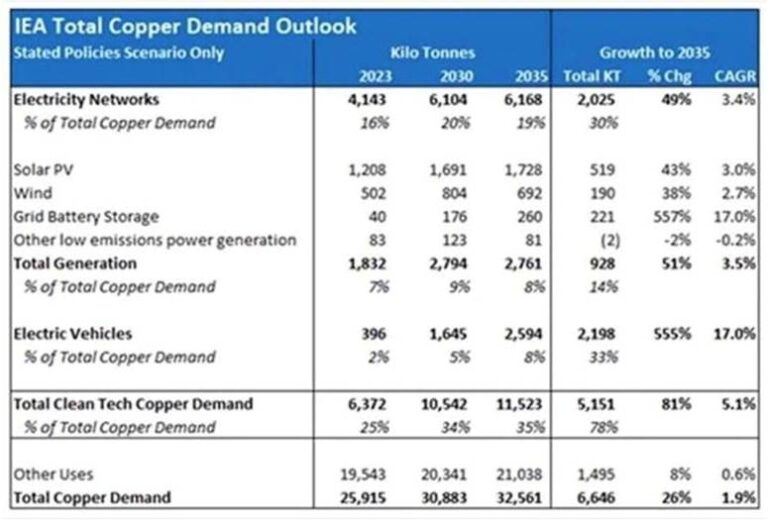
Source: International Energy Agency (IEA)
The IEA expects the copper needs from electricity networks to grow from 4.1Mt in 2023 to 6.2Mt by 2035, an increase of 49%. Copper demand for solar panels is expected to rise by 43% and for wind power by 38% over the same period.
The fastest-growing area, though, is grid battery storage, where copper demand is expected to surge by 557% to 2035 as the need for energy storage increases, Sprott writes.
Copper demand for EVs is a close second, with a projected rise of 555% from 396,000 tonnes in 2023 to 2.6Mt by 2035, with EVs accounting for 8% of global copper consumption by that year.
BHP foresees global copper demand increasing by 70% to reach 50 million tonnes annually by 2050.
Tight supply
On the supply side, BHP points to the average copper mine grade decreasing by around 40% since 1991. The next decade should see between one-third and one-half of the global copper supply facing grade decline and aging mine challenges. Existing mines will produce around 15% less copper in 2035 than in 2024, states the company.
“Most of the high-grade stuff’s already been mined,” says Mike McKibben, an associate professor emeritus of geology at University of California, Riverside, quoted recently by NPR. “So, we have to go after increasingly lower grade material” that costs more to mine and process, he says.
Shon Hiatt, a business professor at the University of Southern California, said, “It’s projected that in the next 20 years, we will need as much copper as all the copper that has ever been produced up to this date.”
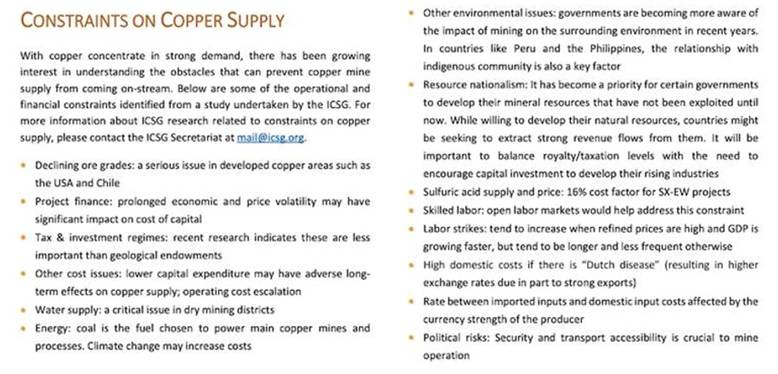
Source: World Copper Factbook 2024
Full-year 2024 copper supply figures are available from the International Copper Study Group. In its January report, the ICSG shows a slight increase in world copper mine production, 22.884 million tonnes in 2024 versus 22.384Mt in 2023.
Last year saw a surplus of refined copper production, 301,000 tonnes, determined by subtracting world refined copper usage of 27.332Mt from world refined copper production of 27.634Mt.
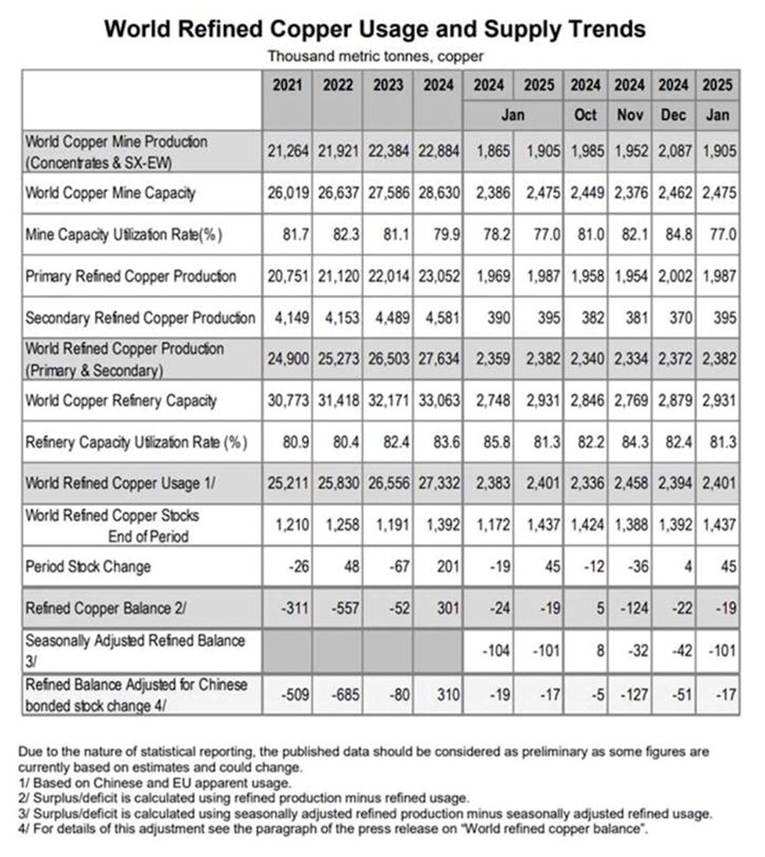
Source: International Copper Study Group
However, that could change as early as this year.
According to Swiss bank UBS, via EV Magazine, the current copper surplus will swing to a deficit exceeding 200,000 tonnes in 2025.
A potential concentrate deficit of 2.2Mt is expected by 2032.
No more copper surpluses — Richard Mills
Conclusion
Ken Hoffman, Red Cloud Securities, and Jesse Colombo, Money Metals, are right. Copper was in a bull market even before the Trump tariffs on copper were announced.
Copper demand remains robust, outpacing supply.
While last year saw a surplus of refined copper production, 301,000 tonnes, the market should swing to a deficit exceeding 200,000 tonnes in 2025.
Spot copper hit a record-high $5.20 a pound in May, that was exceeded on Tuesday by $0.46.
The 50% copper tariff will roil the copper market and not in a good way. In the United States, buyers of refined copper and downstream copper products will be forced to pay the tariff because the United States is not and will not for a long time be self-sufficient in copper.
There are only two primary copper smelters in the US that process mined ore. These are in Miami, Arizona, and Kennecott, Utah. There has been ongoing discussion about increasing domestic copper refining capacity, including potentially restarting idled smelters or building new ones, but these are complex and time-consuming processes.
And it takes up to 20 years to build a new copper mine from scratch. The Resolution copper mine in Arizona has been delayed for a decade and will likely never be built. Ditto for Antofagasta’s mine in Minnesota and the Pebble project in Alaska. Only one mine is slated to start production this year and it’s small: 85 million pounds annual production capacity compared to 700 million pounds produced by Freeport’s Morenci mine last year.
What about using scrap copper? The country lacks the smelting capacity to work through the backlog of scrap that’s been piling up because it’s too expensive to sell to the Chinese.
In 2024 the US imported 810,000 tonnes of refined copper. It exported 60,000 tonnes. So, let’s say the US has 60,000 tonnes of copper that it could refine domestically and sell to local buyers instead of export. That leaves 750,000 tonnes that buyers will have to go outside the States to purchase. In other words, they will have to import copper and pay a 50% tariff.
A 50% price hike will have inevitable ripple effects on the cost of new infrastructure, housing, fridges, cars, air conditioning, etc. Not to mention the cost of maintaining America’s failing electric grid.
Almost every manufacturing process uses copper, and it just got 50% more expensive. Do companies have the margins to absorb such a cost increase? No. They will be passed onto the consumer.
The low dollar (~-15%) makes imports even more expensive.
Richard (Rick) Mills
aheadoftheherd.com
********







